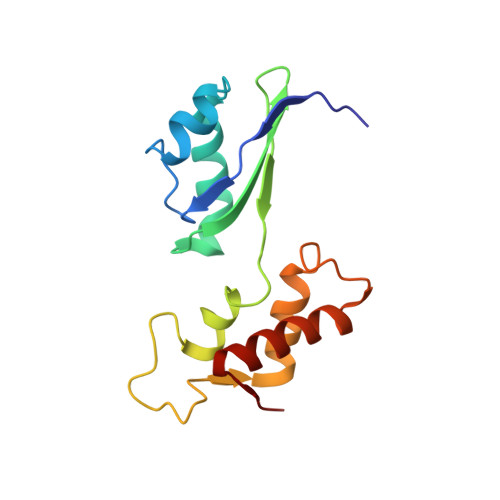Domain reorientation and induced fit upon RNA binding: solution structure and dynamics of ribosomal protein L11 from Thermotoga maritima
Ilin, S., Hoskins, A., Ohlenschlager, O., Jonker, H.R.A., Schwalbe, H., Woehnert, J.(2005) Chembiochem 6: 1611-1618
- PubMed: 16094695
- DOI: https://doi.org/10.1002/cbic.200500091
- Primary Citation of Related Structures:
2K3F - PubMed Abstract:
L11, a protein of the large ribosomal subunit, binds to a highly conserved domain of 23S rRNA and mediates ribosomal GTPase activity. Its C-terminal domain is the main determinant for rRNA binding, whereas its N-terminal domain plays only a limited role in RNA binding. The N-terminal domain is thought to be involved in interactions with elongation and release factors as well as with the antibiotics thiostrepton and micrococcin. This report presents the NMR solution structure of the full-length L11 protein from the thermophilic eubacterium Thermotoga maritima in its free form. The structure is based on a large number of orientational restraints derived from residual dipolar couplings in addition to conventional NOE-based restraints. The solution structure of L11 demonstrates that, in contrast to many other multidomain RNA-binding proteins, the relative orientation of the two domains is well defined. This is shown both by heteronuclear 15N-relaxation and residual dipolar-coupling data. Comparison of this NMR structure with the X-ray structure of RNA-bound L11, reveals that binding not only induces a rigidification of a flexible loop in the C-terminal domain, but also a sizeable reorientation of the N-terminal domain. The domain orientation in free L11 shows limited similarity to that of ribosome-bound L11 in complex with elongation factor, EF-G.
Organizational Affiliation:
Institute of Organic Chemistry and Chemical Biology, Center for Biomolecular Magnetic Resonance, Johann Wolfgang Goethe Universität, Marie-Curie-Strasse 11, 60439 Frankfurt am Main, Germany.














